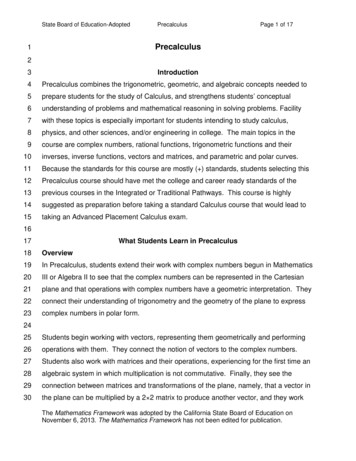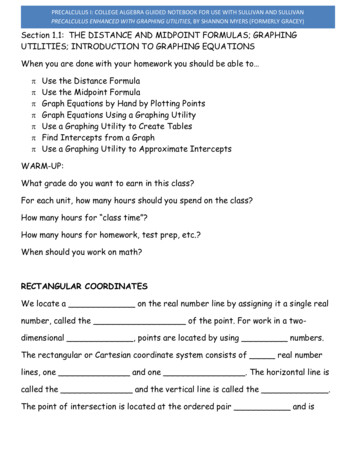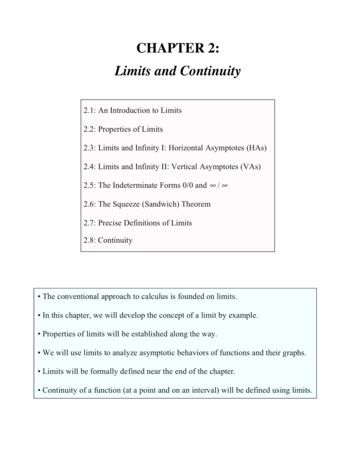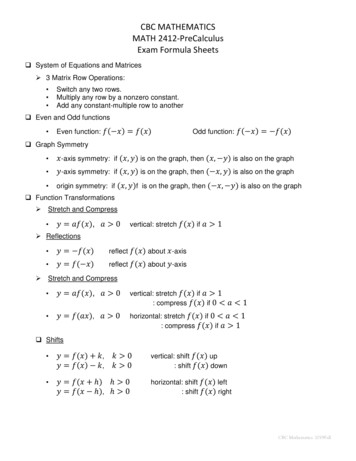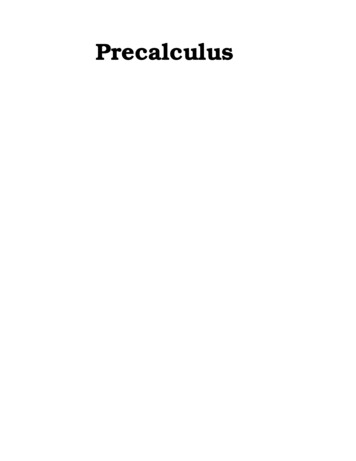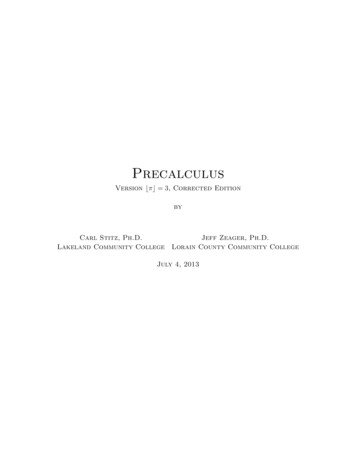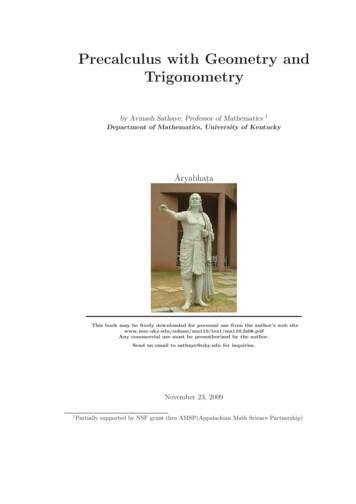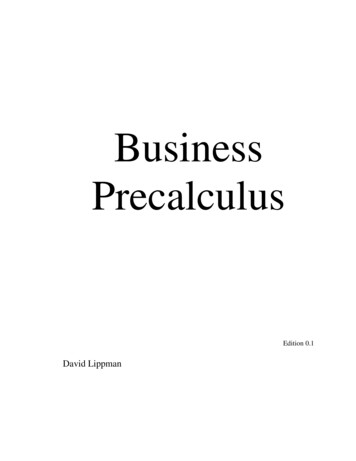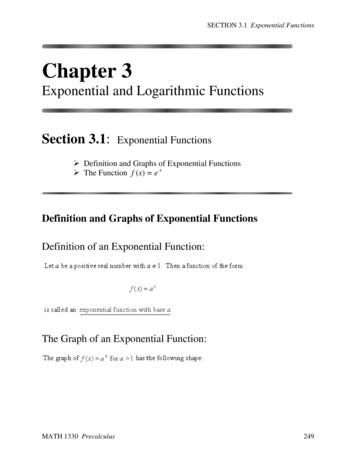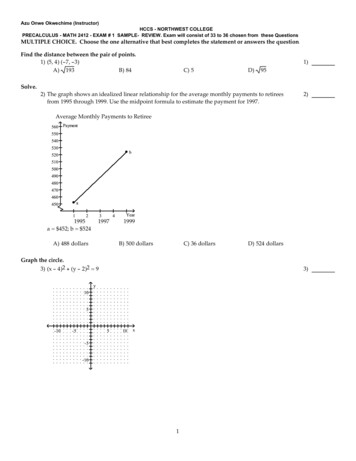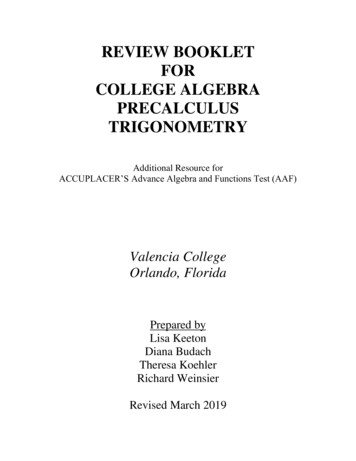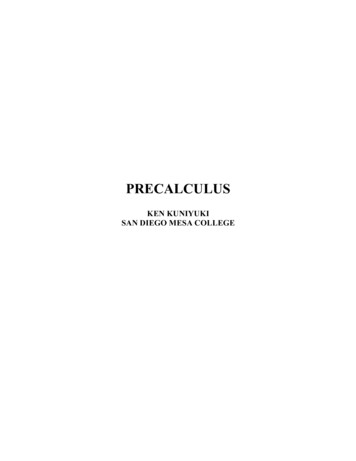
Transcription
PRECALCULUSKEN KUNIYUKISAN DIEGO MESA COLLEGE
TABLE OF CONTENTSChapter 0: Preliminary TopicsChapter 1: FunctionsChapter 2: Polynomial and Rational FunctionsChapter 3: Exponential and Logarithmic FunctionsChapter 4: Trigonometric FunctionsChapter 5: Analytic TrigonometryChapter 6: Topics in TrigonometryChapter 7: SystemsChapter 8: Matrices and DeterminantsChapter 9: Discrete MathematicsChapter 10: Conic Sections, Polar Coordinates, and Plane CurvesCOLOR CODINGWarnings are in red.Tips are in purple.Calculus comments are (sometimes) in green (clover).TECHNOLOGY USEDThis work was produced on Macs with Microsoft Word, MathType, Adobe Illustrator,Adobe Acrobat, and Mathematica and Calculus WIZ.CONTACT INFORMATIONKen Kuniyuki:Email address: kkuniyuk@yahoo.com or kkuniyuk@sdccd.eduWebsite: http://www.kkuniyuk.com You may download these and other course notes, exercises, and exams.Feel free to send emails with suggestions, improvements, tricks, etc.LICENSINGThis work may be freely copied and distributed without permission under thespecifications of the Creative Commons License at: http://www.kkuniyuk.com/Math141PARTIAL BIBLIOGRAPHY / SOURCESAlgebra: Blitzer, Lial, Tussy and GustafsonTrigonometry: Lial, SmithPrecalculus: Axler, Cohen, Larson, Stewart, Sullivan; REA Problem SolversCalculus: Hamming, Larson, Stewart, Swokowski, Tan, [Peter D.] TaylorComplex Variables: Churchill and Brown, Schaum’s OutlinesDiscrete Mathematics: RosenOnline: Britannica Online Encyclopedia: http://www.britannica.comWikipedia: http://www.wikipedia.orgWolfram MathWorld: http://mathworld.wolfram.com/Other: Harper Collins Dictionary of MathematicsPeople: Larry Foster, Laleh Howard, Terrie Teegarden, Tom Teegarden (especially for the FrameMethod for graphing trigonometric functions), and many more.
(Assumptions and Notation) A.1ASSUMPTIONS and NOTATIONUnless otherwise specified, we assume that: f , g, and s denote functions. (See Section 1.1.) g sometimes denotes Earth’s gravitational constant. h may denote a function, or it may denote the “run” in some differencequotients in Sections 1.10 and 1.11. s often denotes a position or height function. a, b, c, k, m, and n denote real numbers. (See Section 0.1.) “Let a ” means “let a be an arbitrary real number.”By “arbitrary,” we mean that any one will do. c sometimes denotes the speed of light in a vacuum. d sometimes denotes a distance function. e denotes a mathematical constant defined in Chapter 3. e 2.718 .() i sometimes denotes the imaginary unit defined in Chapter 2 i 1 .In Chapter 9, we will use i as a generic subscript (as in ai ) and as an indexn of summation as in ai ; we also use j and k for these purposes. i 1 n might be restricted to be an integer ( n ) . (See Section 0.1.) x, y, t, and θ typically denote variables that take on real numbers as values. z can denote a variable or a complex number (see Chapter 2). The domain of a function f , which we will denote by Dom ( f ) , is the implied(or mathematical) domain of f . (See Section 1.1.) This might not be the case in applied “word problems.” We assume that the domain and the range of a function only consist ofreal numbers, as opposed to imaginary numbers. That is, Dom ( f ) , andRange ( f ) . ( means “is a subset of”; see Section 0.1.) Graphs extend beyond the scope of a figure as expected, unless endpoints areclearly shown. Arrowheads help to make this clearer. (See Section 1.2.)
(Assumptions and Notation) A.2MORE NOTATIONSets of Numbers (Section 0.1)Notation , Z , Z , Q , R , CMeaningCommentsThis is the set (collection) {1, 2, 3, .} .“Zahlen” is a related German word. is in blackboard bold typeface; it is morecommonly used than Z.This set consists of the positive integers, thethe set of integersnegative integers ( 1, 2, 3, ), and 0.This set includes the integers and numbers19the set of rational numbers such as , , 7.13, and 14.3587 .34 comes from “Quotient.”This set includes the rational numbers andirrational numbers such as 2 , π , e, andthe set of real numbers0.1010010001 . Think: “all decimalnumbers.”This set includes the real numbers andthe set of complex numbersimaginary numbers such as i and 2 3i .the set of positive integersThe Venn diagram below indicates the (proper) subset relations: .For example, every integer is a rational number, so . ( permits equality.)Each disk is contained within each larger disk.
(Assumptions and Notation) A.3Set Notation (Section 0.1)NotationMeaning in, is in not in, is not insuch thatsuch that(in set-builder form)for all, for anythere is, there exists !there exists a unique,there is one and only one x for every real number(denoted by x) x, y for every pair of realnumbers(denoted by x and y) or : or {}empty set (or null set) set union set intersection\ or set difference,set complementCommentsThis denotes set membership.Example: 7 .Example: 1.7 .Example: { x x 3} , or { x : x 3} ,is the set of all real numbers greater than 3.This is called the universal quantifier.This is called the existential quantifier.This is called the unique quantifier.Example: !x x 3 , which states thatthere exists a unique real number equal to 3.More precisely: for any arbitrary member ofthe set of real numbers; this member will bedenoted by x.Example: x , x x 1 ; that is, everyreal number is less than one added to itself.More precise notation: ( x, y ) 2 .This is the set consisting of no members.Example: The solution set of the equationx x 1 is .The symbol is not to be confused withthe Greek letter phi ( φ ).Example: If f ( x ) csc x , thenDom ( f ) ( , 1] [1, ) . is used to indicate that one or more realnumber(s) is/are being skipped over.Think: “all members are invited.”Example: [ 4, 6 ] [ 5, 7 ] [ 5, 6 ] .Think: “overlap.”1, then Dom ( f ) isx \ {0} , or {0} . We exclude 0 from .Example: If f ( x )
(Assumptions and Notation) A.4Logical Operators (Sections 0.1, 0.2)NotationMeaning or, disjunctionCommentsExample: If f ( x ) csc x , thenDom ( f ) { x x 1 x 1} . and, conjunction or not, negation impliesif and only if (iff)x 3, thenx 4Dom ( f ) { x x 3 x 4 } .Example: If f ( x ) Example: The statement ( x 3) isequivalent to the statement x 3 .Example: x 2 x 2 4 .Example: x 1 3 x 2 .Greek LettersThe lowercase Greek letters below (especially θ ) often denote angle measures.NotationαNamealphaβbetaγgammaθthetaφ or ϕphiCommentsThis is the first letter of the Greek alphabet.This is the second letter of the Greekalphabet.This is the third letter of the Greek alphabet.This is frequently used to denote anglemeasures.This is not to be confused with , whichdenotes the empty set (or null set).1 5,2which is about 1.618. Tau (τ ) is also used.φ also denotes the golden ratio,The lowercase Greek letters below often denote (perhaps infinitesimally) small positivequantities in calculus, particularly when defining limits.NotationNameδdeltaεepsilonCommentsThis is the fourth letter of the Greekalphabet.This is the fifth letter of the Greek alphabet.This is not be confused with , whichdenotes set membership.
(Assumptions and Notation) A.5Some other Greek letters of interest:NotationNameΔ(uppercase) deltaκ(lowercase) kappaλ(lowercase) lambdaπ(lowercase) piΠ(uppercase) piρ(lowercase) rhoΣ(uppercase) sigmaτ(lowercase) tauω(lowercase) omegaΩ(uppercase) omegaCommentsThis denotes “change in” or increment.ΔyExample: slope is often written as.ΔxIt also denotes the discriminant, b 2 4ac ,from the Quadratic Formula.This denotes the curvature of a curve.This denotes an eigenvalue (in linearalgebra), a Lagrange multiplier (inmultivariable optimization), and awavelength (in physics).This is a famous mathematical constant.It is the ratio of a circle’s circumference toits diameter.π 3.14159 . It is irrational.This is the product operator.This denotes mass density and also thedistance between a point in 3-space and theorigin ( ρ is a spherical coordinate).This is the summation operator.See Chapter 9.This denotes the golden ratio, though phi(φ ) is more commonly used.This is the last letter of the Greek alphabet.It denotes angular velocity.This denotes ohm, a unit of electricalresistance.More lowercase Greek letters:zeta (ζ ) , eta (η ) , iota (ι ) , mu ( µ ) , nu (ν ) , xi (ξ ) , omicron (ο ) , sigma (σ ) ,upsilon (υ ) , chi ( χ ) , psi (ψ )
(Assumptions and Notation) A.6GeometryNotation Meaningangleis parallel tois perpendicular to,is orthogonal to,is normal toCommentsSee Section 4.1.See Section 0.14 and Chapter 6.See Section 0.14 and Chapter 6.Vector OperatorsNotation Meaningdot product,Euclidean inner productcross product,vector productCommentsSee Chapter 6.See Chapter 8.Other NotationsNotationMeaning thereforeQ.E.D., or end of proof , is approximately,is about or floor, greatest integer minmaxDom ( f )deg ( f ( x ))infinityminimummaximumdomain of a function fdegree of a polynomialf ( x) composition of functionsCommentsThis is placed before a concludingstatement.Q.E.D. stands for “quod eratdemonstrandum,” which is Latin for“which was to be demonstrated / proven /shown.”Think: “round down.”Examples: 2.9 2 , 2.9 3See Section 0.1.The least of The greatest of The set of legal (real) input values for fSee Section 0.6.Example: ( f g ) ( x ) f ( g ( x )) .See Section 1.6.
CHAPTER 0:Preliminary Topics0.1: Sets of Numbers0.2: Logic0.3: Rounding0.4: Absolute Value and Distance0.5: Exponents and Radicals: Laws and Forms0.6: Polynomial, Rational, and Algebraic Expressions0.7: Factoring Polynomials0.8: Factoring Rational and Algebraic Expressions0.9: Simplifying Algebraic Expressions0.10: More Algebraic Manipulations0.11: Solving Equations0.12: Solving Inequalities0.13: The Cartesian Plane and Circles0.14: Lines0.15: Plane and Solid Geometry0.16: Variation This chapter will review notation, concepts, skills, techniques, and formulasneeded in precalculus and calculus. Sections 0.2, 0.8, 0.9, 0.10, and 0.16 may belargely unfamiliar to incoming precalculus students.
(Section 0.1: Sets of Numbers) 0.1.1SECTION 0.1: SETS OF NUMBERSLEARNING OBJECTIVES Be able to identify different sets of numbers. Know how to write sets of real numbers using set-difference, set-builder,graphical, and interval forms. Be able to take the union and intersection of intervals of real numbers.PART A: DISCUSSION Theorems and formulas require constants (denoted by c, a1 , a2 , etc.) to be from aparticular set of numbers, usually the set of real numbers (denoted by ). Sets of real numbers can correspond to solutions of equations (in Section 0.11),solutions of inequalities (in Section 0.12), and domains and ranges of functions(in Section 1.1). There are several ways to describe these sets.PART B: SETS OF NUMBERSA set is a collection of objects, called the members (or elements) of the set. Two sets A and B are equal (that is, A B ) when they consist of the samemembers. Typically, order is irrelevant, and members are not repeated. denotes the empty set (or null set), the set consisting of no members.Let A and B be sets. A is a subset of B, denoted by A B , when every memberof A is also a member of B.If A B , but A B , then A is a proper subset of B, denoted by A B .This means that B contains all of the members of A, as well as at least one othermember not in A.Some important sets of numbers are: , or Z , the set of positive integers. This set consists of 1, 2, 3, etc. comes from the German word “Zahlen.” is in blackboard bold typeface. It is more commonly used than Z. WARNING 1: Sources differ as to whether counting numbers,whole numbers, and natural numbers also include 0.
(Section 0.1: Sets of Numbers) 0.1.2 , or Z, the set of integers. This set consists of 1, 2, 3, etc.; their opposites, 1 , 2 , 3 , etc.(making up , the set of negative integers); and 0. , or Q, the set of rational numbers. This is the set of all numbers that can be written in the form:integernonzero integer It is the set of numbers that can be written as finite (or terminating)decimals or repeating decimals. Examples include:Fraction form1213823 99007, or 71Decimal form0.50.3, or 0.3333 0.831, or 0.8313131 7 As demonstrated by the last example, every integer is a rationalnumber. That is, . comes from “Quotient.” , or R, the set of real numbers. This is the set of all numbers that can be written as decimals. This set can be represented by the real number line below.There should be tick marks at 0 and at least one other number toindicate scale. This set consists of rational numbers and irrational numbers, suchas π and2.
(Section 0.1: Sets of Numbers) 0.1.3 , or C, the set of complex numbers. This set consists of real numbers and imaginary numbers, such asi and 2 3i. (See Chapter 2.)The Venn diagram below indicates the (proper) subset relations: . Each disk is contained within each larger disk.PART C: SET NOTATIONSet Notation denotes “in,” or “is in.” It denotes set membership. denotes “is not in.” denotes “such that.” (the universal quantifier) denotes “for all” or “for every.” (the existential quantifier) denotes “there exists” or “there is.”Example Set 1 (Using Set Notation)7 1 2 x , a, b , x , x x 1 x , y x 2y§Plain English translation7 is an integer.1is not an integer.2For all real numbers x, For all integers a and b, Every real number is less than one added to itself.Every real number is twice some real number.
(Section 0.1: Sets of Numbers) 0.1.4PART D: INFINITYInfinity, denoted by the lemniscate , is a quantity that is greater than anyreal number.Negative infinity, denoted by , is a quantity that is lesser than anyreal number.WARNING 2: and are not real numbers, though they may be handleddifferently in higher math.PART E: REPRESENTING SETS OF REAL NUMBERSThere are various ways to represent a set of real numbers.We sometimes list the members of a set and surround them with braces.For example, the set 1, π consists of the two members 1 and π .{ }An interval corresponds to a connected (“unbroken”) piece of the real numberline.A bounded interval has finite length on the real number line.An unbounded interval has infinite length.An open interval excludes its endpoints.A closed interval includes its endpoints.Example 2 (A Bounded, Open Interval)The set of all real numbers x such that 3 x 5 in set-builder form is:{x }3 x 5 , or{ x : 3 x 5 } in graphical form is: in interval form is:(3, 5)The set is an interval with 3 and 5 as its endpoints.The set is an open interval, because it excludes its endpoints.The exclusion of 3 and 5 is indicated by the use of: strict inequality signs ( ) in set-builder form, hollow circles (or parentheses) in graphical form, and parentheses in interval form. §
(Section 0.1: Sets of Numbers) 0.1.5Example 3 (A Bounded, Closed Interval)The set of all real numbers x such that 3 x 5 in set-builder form is:{x }3 x 5 , or{ x : 3 x 5 } in graphical form is: in interval form is: 3, 5 The set is a closed interval, because it includes its endpoints.The inclusion of 3 and 5 is indicated by the use of: weak inequality signs ( ) in set-builder form, filled-in circles (or brackets) in graphical form, and brackets in interval form. §Example Set 4 (Various Types of Intervals)Set-builderForm{x 3 x 5 }{x 3 x 5 }{x x 3 }{x x 3 }{x x 3 }{x x 3 }{x x } ,which is GraphicalFormIntervalForm) 3, 5(3, 5 (3, ) 3, )( , 3)( , 3 ( , )Type dedUnboundedUnboundedUnboundedUnbounded§WARNING 3: In interval form, parentheses are always placed next to and , because they are not real numbers and are therefore excluded from the set.However, may be considered to be both an open interval and a closed interval.
(Section 0.1: Sets of Numbers) 0.1.6.A B , the union of set A and set B, consists of all elements in one or both sets.Think: “All members are invited.”{} A B x x A or x B , where “or” is taken to be “inclusive or,” or“and/or.” The disjunctive symbol denotes “or.”A B , the intersection (“overlap”) of set A and set B, consists of all elements inboth sets.{} A B x x A and x B . The conjunctive symbol denotes “and.”Example 5 (A Union of Intervals){ }The set \ 1, π , which is written in set-difference form, consists of all realnumbers except 1 and π . The set in set-builder form is:{x }x 1 and x π , or{ x : x 1 andx π } in graphical form is: in interval form is:( , 1) (1, π ) (π , )TIP 1: The graphical form can help us write the interval form.TIP 2: The union symbol separates intervals in interval form whenevera real number must be “skipped over.” §Example 6 (Union and Intersection of Intervals)( )( )))a) Simplify 1, 5 3, . (Think: “All members are invited.”)b) Simplify 1, 5 3, . (Think: “Overlap.”)§ SolutionIntervalForm(1, 5) 3, )( )) ( )b) (1, 5) 3, ) 3, 5)a) 1, 5 3, 1, §GraphicalForm
(Section 0.2: Logic) 0.2.1SECTION 0.2: LOGICLEARNING OBJECTIVES Be able to identify and use logical notation and terminology. Understand the structure of “if-then” and “if and only if” statements. Understand counterexamples and logical equivalence. Know how to find the converse, inverse, and contrapositive of an “if-then” statement. Understand necessary conditions and sufficient conditions.PART A: DISCUSSION Although logic is a subject that is often relegated to courses in discretemathematics, computer science, and electrical engineering, its fundamentals areessential for clear and precise mathematical thought. Many theorems are “if-then” or “if and only if” statements.PART B: PROPOSITIONS AND “IF-THEN” STATEMENTSA proposition is a statement that is either true or false.“If-Then” StatementsThe statement “If p, then q” can be written as “ p q .” The proposition p is called the hypothesis, assumption, or condition. The proposition q is called the conclusion. If there are no cases where p is true and q is false, we say that thestatement is true. Otherwise, the statement is false, and any case where p is true andq is false is called a counterexample.If the statement is known to be true, we can write “ p q .”“ ” may be read as “implies.” WARNING 1: “ ” denotes “approaches” when we discuss limits incalculus.
(Section 0.2: Logic) 0.2.2Example 1 (An “If-Then” Statement)Consider the statement: “If I get an A, then I pass.”This statement is of the form “If p, then q,” where:p is the hypothesis “I get an A,” andq is the conclusion “I pass.”The statement is true, because there is no case where a student gets an A butdoes not pass. §The converse of p q is q p .Example 2 (An “If-Then” Statement and Its Converse)Consider the statement:“If a number is an integer, then it is a rational number.” That is, ( x ) ( x ) .The statement is true, because every integer is also a rational number.We can write: ( x ) ( x ) .Now, consider the converse of the above statement:“If a number is a rational number, then it is an integer.” That is, ( x ) ( x ) .This second statement is false, because a counterexample exists.1Observe that is a rational number, yet it is not an integer.2WARNING 2: The discovery of even one counterexample can beused to disprove a statement (that is, to prove that a statement isfalse). However, a single example is usually not enough to prove thata statement is true. To prove that a statement is true, one often needsto present a rigorous and general argument that applies to all caseswhere the hypotheses hold.Because the converse is false, we can write: ( x ) ( x ) ,where “ ” denotes “does not imply.” §
(Section 0.2: Logic) 0.2.3PART C: “IF AND ONLY IF” (or “IFF”) STATEMENTS“If and Only If ” (or “Iff”) StatementsThe statement “p if and only if q,” or “p iff q,” can be written as “ p q .”If the statement is known to be true, we can write “ p q ,” or “ p q .” If p q , and if q p , then p q . Then, the propositions p and q are logically equivalent;either both are true, or both are false.() () For example, 2x 6 x 3 . (See Footnote 1.) Definitions are essentially “iff” statements. For example, a number is a rationalintegernumber iff it can be written in the form.nonzero integer True “iff” statements arise when an “if-then” statement and its converse are true.PART D: CONVERSE, INVERSE, AND CONTRAPOSITIVEThe converse of p q is:The inverse of p q is:q p p q “ ” and “ ” are used to denote “not.” They are negation operators.The contrapositive of p q is: q p TIP 1: Take the original statement, switch the propositions, andnegate them.Contrapositive TheoremIf an “if-then” statement is true, then its contrapositive must be true, andvice-versa. In other words, they are logically equivalent.() ()That is, p q q p . This can be proven using truth tables in a discrete mathematics class.As a result, any “if-then” statement you know to be true has acontrapositive associated with it that will automatically be true.WARNING 3: An “if-then” statement may or may not be logically equivalent toits converse or its inverse. (However, the converse and the inverse must belogically equivalent to each other. Why? How are they related?)
(Section 0.2: Logic) 0.2.4Example 3 (Converse, Inverse, and Contrapositive of an “If-Then” Statement;Revisiting Example 1)Consider the true “if-then” statement: If I get an A , then I pass . pqWhat are its converse, inverse, and contrapositive? Which of these are true?§ SolutionConverse:If I pass , then I get an A . qpThis statement is false, because we can find a counterexample.A student can pass the class with a grade of B or C.Inverse:If I do not get an A , then I do not pass . p qThis statement is false, because we can find a counterexample.A student can have a grade of B or C, and the student can pass.Contrapositive: If I do not pass , then I do not get an A . q pBy the Contrapositive Theorem, this must be true, since the originalstatement is.The Venn diagram below may clarify matters. (We ignore “ ” and “ ”modifiers, as well as pass/fail grading.)§
(Section 0.2: Logic) 0.2.5.Example 4 (An “Iff” Statement)Consider the (true) statement:If I get an A, B, or C , then I pass . pqIts converse is true:If I pass , then I get an A, B, or C . qpTherefore, this is true:I get an A, B, or C iff I pass . § pqPART E: NECESSARY CONDITIONS and SUFFICIENT CONDITIONS(p is a necessary condition for q q p) That is, for q to be true, it is required that p must be true.(p is a sufficient condition for q p q) That is, if p is true, then it is guaranteed that q must be true.Example 5 (Necessary Conditions and Sufficient Conditions; Revisiting Example 1)Consider the “if-then” statement: If I get an A , then I pass . pqIs p sufficient for q? Is p necessary for q?§ Solutionp is sufficient for q, because p q . (Equivalently, q is necessary for p.)Think: If I get an A, then I am guaranteed to pass.p is not necessary for q, because q p .Think: I don’t need to get an A to pass. §Example 6 (“Necessary and Sufficient” Conditions; Revisiting Example 4)Consider the “iff ” statement: I get an A, B, or C iff I pass . pqThis is true, so p q , and we say that p is necessary and sufficient for q.Therefore, p and q are logically equivalent. §FOOTNOTES1. Propositions. Unlike some sources such as Rosen’s Discrete Mathematics and Its Applications,we call “ 2x 6 ” a proposition, even though its truth value (“true” or “false”) depends on thevalue of x.
(Section 0.3: Rounding) 0.3.1SECTION 0.3: ROUNDINGLEARNING OBJECTIVES Be able to round off decimals to a specified decimal place, a specified number ofdecimal places, or a specified number of significant digits (or figures). Understand scientific notation.PART A: DISCUSSION (WARNINGS and TIPS) Using CalculatorsMemory buttons on calculators can help preserve decimal accuracy.Taking too few decimal places may ruin the accuracy of final answers.A calculator might approximate π as 3.14159265. Though seeminglyimpressive, this is not an exact representation of π . Calculators cannotgive exact decimal representations of such numbers as 2 , ln5 , and sin 37 . Exact vs. Approximate AnswersMath instructors typically expect exact answers, though decimalapproximations may be required for “word problems.”For example, if an answer is π , you should write π .You may also be asked to give a decimal approximation such as 3.14. “Word Problems”Depending on context, decimal answers might need to be rounded down,rounded up, or rounded off.Write any appropriate units such as feet, pounds, etc. as part of your answer.PART B: ROUNDING“ ” means “is approximately” or “is about.”Example 1 (Rounding Off to a Specified Decimal Place)π 3.14159 . π rounded off to the nearest integer is:3 tenth (that is, to one decimal place) is:3.1 hundredth (that is, to two decimal places) is:3.14 thousandth (that is, to three decimal places) is: 3.142 In the U.S., the “1” in the third decimal place of π is rounded up to “2.”This is because the digit in the next decimal place is 5 or higher.(Different countries have different rules if that digit is a “5.”) §
(Section 0.3: Rounding) 0.3.2.Consider a number written in decimal form.To count decimal places, count all digits to the right of the decimal point.To count significant digits (or figures), locate the leftmost nonzero digit, andcount it and all digits to the right of it. We may want numbers written out to the same number of decimal places whenadding and subtracting them, while we may focus on significant digits whenmultiplying and dividing them. We can also use significant digits to roughlyretain the same level of accuracy when handling different units such as inches,feet, and miles.Example 2 (Counting Decimal Places and Significant Digits)Consider: 70.1230 This is written out to four decimal places.We count the four digits after the decimal point. This is written out to six significant digits.We include the two digits to the left of the decimal point. The “0” at the end indicates that we claim accuracy to four decimalplaces. Writing “70.123” might not have had that effect. We call 70 the integer part of this decimal. §Example 3 (Counting Decimal Places and Significant Digits; Scientific Notation)Consider: 0.001020, or .001020 (the integer part is 0; writing it is optional). These are written out to six decimal places. We count all six digitsafter the decimal point, including the two zeros after the decimal pointand before the “1.” These are written out to four significant digits. We do not includethe aforementioned zeros, but we include the “1” and all digits after it. These can be written as 1.020 10 3 using scientific notation.The “ 3 ” exponent tells us to move the decimal point three places tothe left to obtain .001020 in standard form. Note that:1.020 103 1020. 1020 , since the “3” exponent tells us to move thedecimal point three places to the right. §
(Section 0.4: Absolute Value and Distance) 0.4.1SECTION 0.4: ABSOLUTE VALUE AND DISTANCELEARNING OBJECTIVES Be able to formally define absolute value. Know how to take the absolute value of a real number. Know properties of the absolute value operation. Relate absolute value and distances on the real number line.PART A: DISCUSSION Understanding the definition of absolute value is crucial to understanding theabsolute value function and its graph. (See Section 1.3.)PART B: ABSOLUTE VALUEDefinition of Absolute ValueThe absolute value of a is denoted by a , where a, if a 0a a, if a 0 That is, the absolute value of a nonnegative real number is itself,while the absolute value of a negative real number is its opposite. This is an example of a piecewise definition because of the different rulesfor different values of a. (See Section 1.5.)TIP 1: The absolute value of a real number is never negative.WARNING 1: a does not necessarily represent a negative value. In fact,if a 0 , then a 0 . That is, the opposite of a negative real number is positive.Example 1 (Finding Absolute Value)a) Find 7 . b) Find 0 . c) Find 3 .§ Solutiona) 7 0 , so we use the top rule in the definition. 7 7 .b) 0 0 , so we again use the top rule in the definition. 0 0 .c) 3 0 , so we use the bottom rule in the definition: 3 ( 3) 3 . §
(Section 0.4: Absolute Value and Distance) 0.4.2PART C: PROPERTIES OF ABSOLUTE VALUEProperties of Absolute Value1) a 0Absolute values are never negative. (TIP 1)2) a aOpposites have the same absolute value.The absolute value of a product equals theproduct of the absolute values.The absolute value of a quotient equals thequotient of the absolute values, provided thedenominators are nonzero.3) ab a b4)aa , if b 0bbPART D: ABSOLUTE VALUE, DISTANCE, and OPPOSITESInterpreting Absolute Value as a Distancea the distance between a and 0 on the real number line.TIP 2: Just as for absolute value, a distance cannot be negative. However, we douse “signed distances” and “signed lengths” in trigonometry and motion problems.Example 2 (Interpreting Absolute Value as a Distance) 3 3 and 3 3 , because both 3 and 3 are at a distance of 3 unitsaway from 0 on the real number line.§The Distance Between a and bb a a b the distance between a and b on the real number line. In particular, a 0 a the distance between a and 0 on thereal number line. Absolute value notation allows us to denote such distances withoutworrying about whether a is greater than b or vice
quantities in calculus, particularly when defining limits. Notation Name Comments δ delta This is the fourth letter of the Greek alphabet. ε epsilon . needed in precalculus and calculus. Sections 0.2, 0.8, 0.9, 0.10, and 0.16 may be largely unfamiliar to incoming precalculus students.
